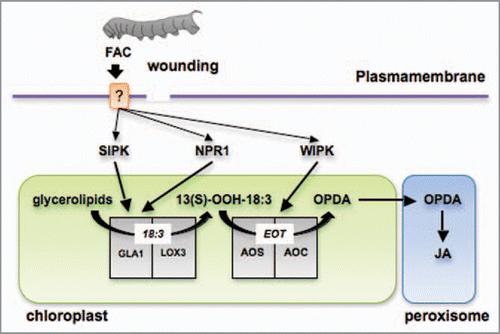Figures & data
Figure 1 Plastids play a central role in the generation of wounding and herbivory induced signals. After wounding and herbivory, several different cellular events take place at the plasmamembrane [e.g., increased ROS production, changes in ion fluxes and plasmamembrane potential, recognition of insect elicitors (e.g., FACs)]. The perception of pathogen elicitors by specific membrane receptors also activates some of these cellular processes. These events lead to the activation of downstream components in the cytosol (arrow 1) that transduce the primary stress signals to activate enzymes located in the plastid (arrow 2). Changes in ion fluxes between the cytosol and the tonoplast may also influence the activity of plastidial enzymes (arrow 3). The plastid reacts to these stimuli by activating the synthesis of fatty acid-derived signals (e.g., oxylipins and structural fatty acids), SA, and isoprenoid volatiles that regulate direct and indirect defense responses (dashed arrows). FAC, fatty-acid amino-acid conjugate; FAS, fatty acid synthase; ACP, acyl carrier protein; ROS, reactive oxygen species; GLA, glycerolipase A; LOX, lipoxygenase; AOS, allene oxide synthase; AOC, allene oxide cyclase; HPL, hydroperoxide lyase; SKP, shikimate pathway; ICS, isochorismate synthase; BA, benzoic acid (* formation of BA requires one cycle of β-oxidation that most likely takes place in the peroxisome); G3P, glyceraldehyde-3-phosphate; DXS, 1-deoxy-D-xylulose-5-phosphate synthase; DXP, 1-deoxy-D-xylulose-5-phosphate; DXR, 1-deoxy-D-xylulose-5-phosphate reductoisomerase; MEP, methyl-D-erythritol 4-phosphate; MT, monoterpenes; DT, diterpenes.
![Figure 1 Plastids play a central role in the generation of wounding and herbivory induced signals. After wounding and herbivory, several different cellular events take place at the plasmamembrane [e.g., increased ROS production, changes in ion fluxes and plasmamembrane potential, recognition of insect elicitors (e.g., FACs)]. The perception of pathogen elicitors by specific membrane receptors also activates some of these cellular processes. These events lead to the activation of downstream components in the cytosol (arrow 1) that transduce the primary stress signals to activate enzymes located in the plastid (arrow 2). Changes in ion fluxes between the cytosol and the tonoplast may also influence the activity of plastidial enzymes (arrow 3). The plastid reacts to these stimuli by activating the synthesis of fatty acid-derived signals (e.g., oxylipins and structural fatty acids), SA, and isoprenoid volatiles that regulate direct and indirect defense responses (dashed arrows). FAC, fatty-acid amino-acid conjugate; FAS, fatty acid synthase; ACP, acyl carrier protein; ROS, reactive oxygen species; GLA, glycerolipase A; LOX, lipoxygenase; AOS, allene oxide synthase; AOC, allene oxide cyclase; HPL, hydroperoxide lyase; SKP, shikimate pathway; ICS, isochorismate synthase; BA, benzoic acid (* formation of BA requires one cycle of β-oxidation that most likely takes place in the peroxisome); G3P, glyceraldehyde-3-phosphate; DXS, 1-deoxy-D-xylulose-5-phosphate synthase; DXP, 1-deoxy-D-xylulose-5-phosphate; DXR, 1-deoxy-D-xylulose-5-phosphate reductoisomerase; MEP, methyl-D-erythritol 4-phosphate; MT, monoterpenes; DT, diterpenes.](/cms/asset/b8734303-e15e-48d9-97d6-0c4623060aec/kcib_a_10911834_f0001.gif)
Figure 2 Early enzymatic steps in the JA biosynthesis pathway regulated by SIPK, WIPK and NPR1 after wounding and FAC elicitation. The perception of FACs and/or wounding by the leaf elicits signaling mechanisms that activate the release of 18:3 from membrane glycerolipids. This activation is mediated by SIPK and NPR1 in N. attenuata leaves most likely via the activation of glycerolipase A1 (GLA1). N. attenuata lipoxygenase 3 (LOX3) catalyzes the conversion of the free 18:3 into 13-OOH-18:3 which it is rapidly utilized for the synthesis of OPDA by allene oxide synthase (AOS) and allene oxide cyclase (AOC). WIPK-mediated mechanisms target the activation of OPDA biosynthesis via the regulation of AOS and/or AOC. EOT, 12,13-epoxy-18:3; OPDA, (9S,13S)-12-oxo-phytodienoic acid; JA, jasmonic acid.
